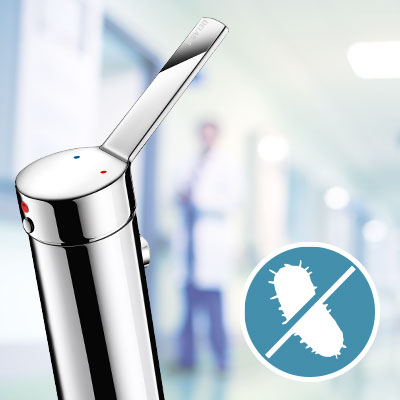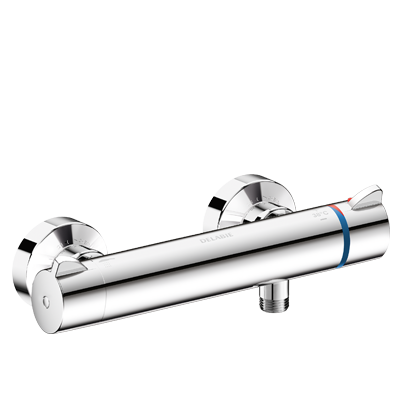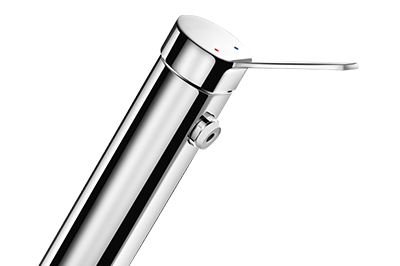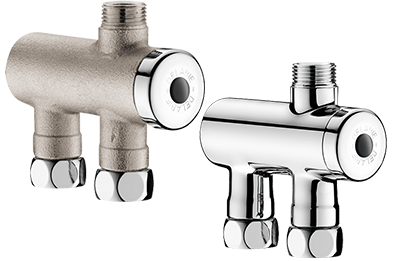
In healthcare facilities, as well as public places, the fight against bacterial proliferation is a constant challenge.
The infections that may result from poor hygiene controls in the system can be potentially very serious.
Mixing the water as close as possible to the point-of-use is an effective technique to tackle this problem.
THE PROBLEM: BACTERIAL PROLIFERATION IN THE WATER SYSTEM
Over time, a natural film develops in water distribution systems which lines the inside of the pipes: biofilm. Bacteria that occur naturally in water attach themselves to this layer which provides ideal conditions in terms of moisture, temperature and nutrients, etc. If it’s not monitored and controlled, bacterial development in the water system can become very problematic.
Among those bacteria that occur naturally, Legionella and Pseudomonas aeruginosa can cause serious nosocomial infections. They can be fatal for people with a fragile immune system.
Legionella develops in the biofilm when the water temperature is between 25°C and 45°C. Below this range and it remains dormant, above this range it will be destroyed. Infection occurs when the user inhales micro-droplets that are expelled from taps that contain the bacteria.
On the other hand, Pseudomonas aeruginosa develops in when the temperature is between 4°C and 42°C (the optimal range is between 30°C and 37°C). It needs air and water to proliferate. So it can be found where these factors unite: essentially this means in the tap, the flexible hose and up to a metre along the pipes in the system. Infection occurs via direct contact, through a wound or mucous membranes.

REGULATIONS & GUIDANCE TO MEET THE CHALLENGES
In 2019, in the UK there were 517 cases of Legionnaire's disease reported by the European Centre for Disease Prevention. In parallel, 4.1 million nosocomial infections were linked to care received in healthcare facilities in Europe. These infections resulted in 37,000 fatalities. This is, therefore, a growing phenomenon within water distribution systems.
In 2014, the Health and Safety Executive recognised this subject and published Health and Safety Guidance 274 Part 2: "The control of legionella bacteria in hot and cold water systems" as guidance to support the Approved Code of Practice and guidance on regulations regarding Legionella control.
For more details about the regulations and guidance that relate to hot and cold water distribution systems in public buildings, see our themed dossier.
AN EFFECTIVE TECHNICAL SOLUTION AGAINST BACTERIA: MIX THE WATER AS CLOSE AS POSSIBLE TO THE POINT-OF-USE
Two measures are essential to prevent bacterial development: reduce the amount of stagnant water in the distribution system to a minimum, and ensure that the hot water is above 50°C at all points in the system.
When a point-of-use is installed on a hot water circulating loop, the contents of the pipework up to the outlets is only purged when they are turned on. If they are not used regularly, the water in the pipework stagnates and cools down to temperatures which encourage bacterial development.
This affects any building where footfall can drop (hospitals, off-season tourism, etc.). This is why the regulations affecting public buildings require that hot water should be distributed so that it delivers a temperature of 50°C (55°C in healthcare premises) within one minute at the outlets.
Mixing the water as close as possible to the point-of-use brings the circulating loop close to the outlet. Doing so ensures that the water circulates at a high temperature to prevent the growth of microorganisms. Once established in the pipework, colonies of bacteria are difficult to dislodge. Therefore, prevention at the design stage is a winning strategy.
It's also essential that regular flushing occurs at the outlets to renew the water and maintain a high level of hygiene in the network. With this in mind, all DELABIE's electronic solutions feature an automatic duty flush which takes place every 24 hours after the last use: nothing is overlooked.

HEALTHCARE FACILITIES: ADAPTED SOLUTIONS
In it's dedicated range for healthcare facilities, hospitals, retirement and care homes, and even clinics, DELABIE offers basin and shower mixers which contain the least amount of stagnant water possible and protect the user from any risk of scalding.
The maximum temperature featured on these mixers facilitates thermal shocks: easily overridden (without shutting off the water supply or removing the control lever on EP versions). Water can circulate at 70°C for half an hour - a curative treatment that takes place if there is a contamination episode in the system.
Many of DELABIE's solutions comply with the French standard NF Medical*.

FOCUS ON THREE ICONIC MIXERS:

FOR SHOWERS, A SAFE AND SECURE DUAL CONTROL MIXER
Certified NF Medical in July 2021, the thermostatic shower mixer H9768TP is specifically designed to minimise the volume of water in the body and which also features anti-scalding safety.
Its thermostatic cartridge ensures stable temperatures regardless of pressure and flow rate variations in the system.
The hot water, limited to a maximum of 43°C, shuts off immediately and automatically if the cold water supply fails. Moreover, it is equipped with Securitouch technology: the mixer body remains cool regardless of the temperature of the mixed water at the outlet. Any risk of scalding or burns is removed.
Another important advantage: this thermostatic mixer has no non-return valves on the inlets! However, defective non-return valves allow cross flow between the hot and cold water, which increases the risk of bacterial development. The design of the H9768TP prevents any cross flow and reduces the risk of bacterial proliferation.

AT THE WASHBASIN, A MIXER WITH NO SPOUT
The 2621EP has no spout which only leaves a very low volume of standing water inside. The basin mixer also has a "thermal shock" and meets the challenges of healthcare facilities.
In addition, it features a pressure-balancing cartridge which compensates for pressure variations in the system. The water temperature at the mixer outlet then remains perfectly stable, avoiding any risk of scalding.

AN "ALL TERRAIN" THERMOSTATIC MIXING VALVE
Developed for public places, the PREMIX NANO 732115 / 732116 is a very small thermostatic mixing valve which is ideal for healthcare facilities.
Hospitals and retirement homes are often fitted with mechanical mixing valves. If there is simultaneous use in the hospital or care home (WC flush, showers, wash basins, etc.) the cold water pressure can vary significantly. Installed upstream of the tap or shower, the PREMIX NANO guarantees temperature stability and anti-scalding safety at all times.
It can supply 2 basin taps or one shower regardless of the configuration. It can be installed anywhere, in a new build or as a refurb.
* French standard NF 077 MM is specifically aimed at medical water controls which has been in force in France since 2017.



